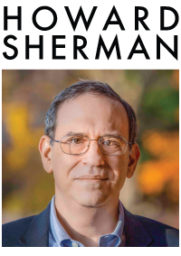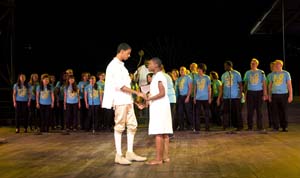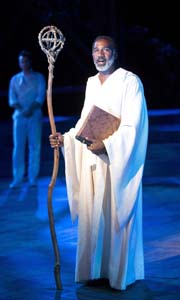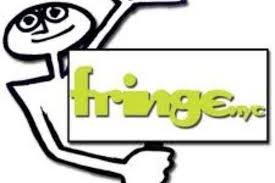
Tommy Bazarian in “Still Life.” (Photo courtesy Yuvika Tolani).
Someone bathing on stage? Commonplace. Two people bathing together on stage? Seen it. Male and female conjoined twins spending almost the complete duration of an hour-long Bulgarian play in bathtub? For that, I needed to go to the Fringe.
Inanimate objects coming to life and talking? Oh, that’s so Toy Story. Two grapes discussing life for 80 minutes? Yup, that’s the Fringe.
I didn’t choose to see these plays. As a Connecticut native, raised on a diet of regional theatre, Broadway and the major Off-Broadway companies, I don’t usually spend a whole lot of time below Union Square. Coming out of college, my drama club friends became doctors and lawyers, so I was never compelled to see productions in fifth-floor downtown Manhattan lofts. Having only moved here a decade ago at age 40 to run the American Theatre Wing, which required me to see every show that opened on Broadway, I’m pretty mainstream by default. But for three days in August, I dove into the New York International Fringe Festival, letting an unknown person fill my days with the kind of theater I would never have selected for myself. What manner of lunatic am I? Let me explain.
As diverse as anyone manages to make their entertainment choices, they are ultimately part of a self-fulfilling plan. Whether it’s a play, a movie, a book or a TV show, our cultural choices are, for the most part, self-curated experiences that align with our existing interests. Only the truly adventurous will opt for an experience about which they know nothing or, even worse, strikes them as unappealing, especially if they have to pay for it. We don’t accidentally find ourselves at Mamma Mia! if we hate musicals, or a football game if we loathe sports.
Even though I see perhaps 125 theatre productions a year, attend about 50 movies in theaters and watch far too much television, I’m still not as omnivorous as the casual (or non-) theatergoer might perceive me to be. It may be hard to perceive limitations in the guy who enjoyed Fast and Furious 6 and is also the aesthete who reveled in the eight-hour marathon “Great Gatsby” adaptation Gatz, but I know my biases and where I prefer not to go. In the cultural arena, even if one is an avid consumer (since my teens) and a professional (since the age of 21) all at once, it’s easy to block out entire swaths of experience, pop and high culture alike. I wanted to get past that, to see if I could still expand my own repertoire.
Presenting some 185 productions in a span of a little more than two weeks, the New York Fringe, with its youthful irreverence, bare bones and anything-goes ethos, struck me as the perfect petri dish in which to conduct an experiment. Like any mad scientist, I made myself the test subject. What would be the effect of an eclectic, perhaps unpolished, theatrical barrage on the psyche of someone with such an establishment history? What would it be like to be subjected to a highly compressed theatergoing binge without any choice in what I would attend? Other than offering up 72 consecutive hours to Narratively and urging my editor (who I know only by Twitter, e-mail and a single phone conversation) to pack the schedule so long as I got time to eat, I committed to three days at the Fringe, taking in whatever I was directed to see, informed of my schedule each morning with minimal time to form advance notions. I know that my four or five shows a day for three days pales compared to die-hards who spend a week in Edinburgh taking in six or seven shows daily, but even this more measured pace struck my friends and my wife as going off the deep end. I had no idea what I’d think when I came out the other side.
And I’m off!
Day 1
My assigned agenda was waiting in my e-mail inbox when I awoke the first morning. It felt a bit like I was Jim Phelps (or Ethan Hunt, for the youngsters) on Mission: Impossible, getting my brief to topple a fictional Latin American dictatorship. Having paid no attention to literature about the Fringe in order to avoid preconceptions, I was a bit disappointed when all of the shows for the day turned out to be in theatres that I knew (although, in the case of The Players Theatre on MacDougal Street, I’d never been inside). Mild adventure at best.
My first show, about a would-be celebrity chef whose absurd concoctions had failed to catch the palate of television executives, began at two p.m. On a Wednesday. Oh, dear god: I’m a matinee lady. Here I thought I was breaking new ground and I start by making myself a cliché. But once I got over my panic, I noticed that the audience was in fact mostly younger than me – this held true at all but two shows. So even though I was a relatively senior patron, I was, comfortingly, at an experience sought out by those ostensibly hipper than myself, albeit theatre geeks like me. I kept waiting for food be thrown into the audience by the increasingly manic chef, wondering whether the front rows might at any moment be showered with diced vegetables, as if at a Gallagher gig. Alas, the premise stayed with self-flagellation for the solo show rather than audience assault.
An hour later, I’m back out into the sunshine. With more than 90 minutes to go until my next show, I check e-mails, tweet, return a couple of calls. But trying to avoid snacking and not being a coffee drinker, I simply have time to kill. My greatest concern in this first break, which is already longer than my time in the theatre so far? Would my phone battery hold out until I get home at midnight. Not unlike the experience of a long wait at an airport, I learn that finding an open power outlet at the Fringe is a beautiful thing.
Next show: a “version” of Gertrude Stein’s Four Saints In Three Acts. I’m pretty sure I saw Four Saints once. I lived in Hartford, Connecticut for a decade, where the 1934 premiere of Stein’s piece took place, and is still referenced as a cultural touchstone when the city is accused of being straight-laced. That I can’t clearly remember the production I saw in Hartford suggests this is going to be a slog.

Daniel Bellomy, Jacob Vine, Jordan Phillips, Mitch Marois,Jimmy Nicholas, Joe Ventricelli and Carter Redwood in “Gertrude Stein SAINTS!” (Photo courtesy Jordan Harrison).
Within 15 minutes of lights up, I’m grabbing for my program, because this sure isn’t anything I remember. This cast looks so young. Who on earth are they? Who put this together? After about four bios I discover a common thread: I’m watching a show featuring undergraduates from Carnegie Mellon University. And while the word’s are Gertrude’s, these kids developed the almost completely a capella score themselves, under the direction of a CMU grad student. Loath as I am to play critic (and it’s not the purpose of my Fringe binge), before it’s half over I’m ready to buy the CD (yes, yes, I know—or download it from iTunes).
Dinner. I wolf down a piece of lasagna across the street, then back into the same theatre (La Mama) for the next show, then a quick sprint across the Village for the final show of the evening. Of these, one is amateurish but well-meaning, the other cynical and tasteless. The only noteworthy moment? During one of these shows, I see the first instance (of what would eventually become four) of simulated or mimed masturbation. Yes, it will become a mini-motif over three days. I don’t realize it right away, but collectively, they add up. Does this say something about the state of our culture? Is the motif a metaphor? Is this being taught in drama schools? I shudder at the possibilities. And I won’t even go into the implications of the show in which a character rhetorically asks to be rectally assaulted with an array of increasingly uncomfortable objects.
When I get home I give my wife the briefest of recaps, as she’s already in bed and halfway to sleep. I’m feeling a bit down, wondering whether I was taking the work on its own terms, something I always advocate, or holding it to the standard of my more conventional theatergoing fare. Have my perception and taste calcified with age and experience, or did I just see a few misfires? I haven’t spent much time in 99-seat, 60-seat, 30-seat theatres. I have to make significant perceptual adjustments for the Fringe, not because I had to make allowances for their constraints, but because I haven’t fully learned to appreciate work that may be truly new, extremely youthful, and made with the barest bones.
Day 2
Time looms before me. Despite one good experience, I do not relish two more days if the ratio of “wins” to “losses” holds at the same rate. Just to add to the fun, a small medical procedure I need to have done is unexpectedly moved up from the following week to this morning. And the day’s roster requires me to consult both subway and street maps.
Confession: I’ve never been on the Lower East Side. I’ve made occasional excursions to East 4th Street (for New York Theatre Workshop and La Mama, where I’d been yesterday), to Lafayette Street (The Public) and to The Flea Theatre in TriBeCa. But in each case, I’ve taken the subway, popping up out of the ground like some cultured gopher, harvesting my treats and jumping back into the hole.
So when I emerge on Delancey Street, I am disoriented. I have to use both the map in the subway station and Google maps to determine where I am and where I’m going. I feel like a tourist. Ten years in New York, but this is terra incognita. At one point, on East Houston Street, I happen to look to my right. Huh, there’s one of those bridges to Brooklyn. I don’t even know which one. Idiot.
I’m early, of course, a congenital habit. I have close to two hours before my first show. Then inspiration hits: I’m now near all of those restaurants I read about in New York magazine (to which I’ve subscribed for decades) but never eat at. Bigger inspiration: isn’t the fabled Shopsins around here somewhere? Carefully and repeatedly consulting Yelp and Google, I find it’s inside the very building I’m in front of. After almost being thrown out by the legendary Kenny S. for having the temerity to ask if I can plug in my phone anywhere, I eat, my choice somewhat limited by my commitment to not give in to mac and cheese pancakes, which seem to be part of every third item.
I have time after lunch, so I wander the streets a bit. Here’s chi-chi WD-40, here’s Katz’s Deli, here’s Russ & Daughters. The Zagat Guide sprung to life. I briefly indulge in a fantasy of my grandparents as immigrants to the U.S., living in these tenement buildings almost a century ago, like characters in a Delmore Schwartz novel. Though I have to admit to myself that I know little of their early lives, or when they’d moved up to Connecticut. With my parents gone, I never will know. If I have heritage here, it’s lost to me.
The first show is at a basement theatre called The Celebration of Whimsy. Reinforcing the tenet embodied in the space’s name, it is also known as the C.O.W. I see a show in which two clowns, squatting in an abandoned home, are confronted by weapons-wielding home invader clowns, in a place called The Cow. This hits a particular chord of mirth for me. Is this what it was like to go to Off-Off-Broadway 50 years ago? Was it this wacky?
Another break. I quickly learn that there aren’t spots to just hang around on the Lower East Side during the day, or at least I can’t find any (I would later discover copious places in the evening, but they’re bars and I don’t drink, plus they’re exceptionally loud). Fortunately, as I trek back to East 4th Street, I pass Fringe Central. Power outlets! I tweet my delight, which results in Elena Holy, who runs the Fringe, emerging out of seeming nowhere to greet me with a hug (we first met when I interviewed her for a podcast back in 2004). Recharged electrically and emotionally, I’m off again.
The next play, about a group of aimless teens (one of whom just happens to be a Satanist) has a really terrific first act (I’m reminded of Eric Bogosian’s Suburbia), and it’s a fully shaped play, not an hour-long sketch. Unfortunately it is let down by its perfunctory second act. I recognize the playwright from her Twitter feed and her acting roles sitting in the row behind me; I have this desperate urge to chat with her about her play. But that’s presumptuous. I don’t know her, I’ve never held an artistic position in the theatre, I’m not a critic. So I remain anonymous, but make a note to see her work in the future. Boy, I wish I could talk with someone about the promise and the problems of this show. Frustrating.
The evening takes me to a venue called Teatro LATEA, housed in an enormous former public school building. I would ultimately see three out of my 13 shows here, and I’m surprised that a building with multiple theatre spaces has completely escaped my notice until now. I see a play about corporate/industrial inhumanity, followed – in the same space, an hour later –by a two-person series of blackout sketches on the theme of romance. The latter is charming, and with some polish could make for a popular entertainment with little of the bohemian aura of the Fringe about it; the former left me somewhat mystified. So day two yielded three qualified wins and only one (not such a terrible) loss. Things are looking up.
Day 3
My god, it’s beautiful out again. When I committed to this experiment, I didn’t stop for a second to think about the distances between venues, or that it might a) rain b) be above 90 degrees c) be stiflingly humid or d) all of the above. But I couldn’t ask for nicer August days in the city. I have no doubt that my attitude towards the whole experience would have been vastly different had I been sweaty or soggy or both. Maybe there is a Thespis after all.

Penko Gospodinov and Anastassia Liutova in “The Spider.” (Photo courtesy Miroslav Veselinov).
The day offers a schedule closer to what I’d originally imagined: five shows between lights up at two p.m. and the final blackout at 10:20 p.m. Today is the day I see the bathtub play and the talking grapes. It is also the day I see solo shows so dire that I am embarrassed for both the performers and the audience. One is a stand-up act that seems to have been cobbled together from a marathon of Comedy Central stand-up material, and yields almost no laughter from anyone, least of all me. Maybe I’m being punked, and this is the next Andy Kaufman? Is this a meta-commentary on stand-up comedy? I think not. The other solo pieces, not comedic, resemble nothing so much as spoofs of exercises in a consciousness-raising group from the 1970s, with a great deal of careful miming to accompany not just actions, but words and thoughts. Isn’t it enough to be told that the sun came up without having it demonstrated? If you say you’re reading, must we watch you flip pages? How much must we learn about that clichéd first trip to buy feminine hygiene products? Oy.
Together, these shows prompt me to wonder that if these made it into the Fringe, which was curated, what on earth were the rejected shows like? Am I being cruel? Perhaps, but that’s part of why I avoid being a critic. I hold very strong opinions about what I see and at this stage of my life, I probably dislike more than I like. It’s not an admirable trait. To be fair, many years ago, Ian McKellen told me that you learn more from watching bad theatre than from good theatre. I should have invited him.
Beyond the tub, the grapes and the shows I will not speak of again, the fifth piece is another promising work with a talented, if not completely in-sync cast, that starts as workplace comedy and ends as a dystopian vision from The Twilight Zone. Again, people to watch for all around in the future, especially as I’ve adjusted my internal critic to consider promising as success.
It’s a shame that I finished with one of the downer shows, as my final day doesn’t exactly send me out on a high. That said, I complete my final day with a reasonable amount of energy. I’m sufficiently stimulated by the past three days that I sleep very little that night, and awaken the next morning as if preparing to head out for day four. But in point of fact, come two p.m., when I might have been back in the theatre, I commence a multi-hour nap, and my Saturday is lost in lethargy and recuperation.
Epiphany
Did I think I would learn something new about theatre when I concocted this scheme? Perhaps. Or maybe I just wanted to set some mini-endurance goal for myself, something that would be a good story to tell friends. “Hey, remember that time I saw 13 shows in three days?” But truth be told, just as I went in blind about what I’d see, my thoughts were comparably inchoate about what I’d discover. These three days of solo theatergoing pointed out several things about myself, and about my relationship to theatre.
I had to grapple with the fact that, as the product of elite theatre, I have been molded into an elitist. In addition to the Wing, I’ve worked at, among others, Goodspeed Musicals, Manhattan Theatre Club and The O’Neill Theatre Center, all well established before I ever set foot near them. That, plus growing up in such proximity to New York, and so very close to the Yale Rep and Long Wharf Theatres, meant I was seeing very highly developed work from the start.
The construct of my Fringe experience also brought home an aspect I’ve not previously contemplated about theatergoing, namely that it is a social experience. I’ve certainly spent plenty of time in theatres (legit and movie) by myself, but it’s not my preference. However, having committed to 13 unknown shows, I couldn’t very well find one person who would want to join me, and the lack of advance schedule meant I couldn’t invite different people to different shows.
As a result, I was largely speechless for the better part of three days (uncharacteristic of me, to say the least) because I was alone and I’m not prone to striking up conversations with people in adjacent seats, or standing next to me while waiting in line. I was able to use the social media lifeline, but sparingly and only intermittently. To top it off, as someone who often attends shows late in previews or early in their runs uptown, I’m used to constantly running into people I know at the theatre; that happened at only a single show. I was among strangers virtually the whole time. My binge was a lonely adventure. That’s not in the Fringe brochure, but it was a lonely stint of my own making.
Corollary to the loneliness was the dislocation. I was a stranger in a strange land. Save for the occasional chain restaurant (one can find Subway and Baskin Robbins on the LES, though I spotted no Starbucks), every storefront was new to me, and because I hadn’t mapped out my trip, I was often at a loss regarding where to go in my limited free time. That eased by day three, as I learned that the Lower East Side isn’t some far-off kingdom; it’s merely a few blocks beyond territory that I know, a couple of stops on the F train that I’ve never taken. I will go back, on a camera safari, on a dining trip with my wife. My island has gotten a bit bigger. What the hell took me so long?
And as for letting someone else choose theatre for me? Even after seeing them, I doubt I would have made any effort to see even one of the pieces I went to, had they been described to me.
What was the scorecard? I found: one show which was an utter surprise and brought unstinting joy; a play by a very promising writer who I plan to follow; two potentially strong pieces with general appeal, but in need of greater polish; a surprisingly charming and thoughtful work about inanimate objects; a clever sketch that would have benefited from firmer direction; a funny idea that was buried inside too much exposition; a singularly unique idea that nearly wore out its welcome; a play that was well intentioned but unskilled; a puzzlement; two shows that were embarrassing for both audience and performers; and one piece that was loathsome.
But as I think about it, adding the Fringe programs to my random stacks of theatre programs that haven’t yet been sent to storage, here’s the funny thing: I wouldn’t be surprised, were I to line up any of my regular theatre-going in 13 consecutive production chunks, if I had the same range of reaction. Might the more finished work that is my usual fare yield a better ratio of hits to misses? Perhaps. But bigger theatres and bigger budgets are no guarantees of success, and I say that as someone who saw Suzanne Somers’s brief Broadway turn in The Blonde in the Thunderbird, a solo autobiography show of massive self-absorption that remains the hilarious nadir of my theatergoing life. That might have been better at the Fringe, funnily enough, perhaps performed in a bathtub. As I’ve learned, it’s all a matter of perspective.
To read this article in its originally published form, visit Narratively.

























